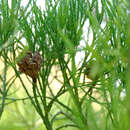en
names in breadcrumbs


Wind-felled trees are used in constructing buildings, bridges and furniture. The roots have high buoyancy and are used to make life buoys, bottle corks, etc. Tannins extracted from the bark and the cone scales are used in tanning, dyeing, and fishing nets. Often planted in wet places for erosion control, as a windbreak, and because it is believed to bring good luck; consequently the tree is not normally deliberately felled by villagers.
Glyptostrobus pensilis, known in Chinese as 水松 (Shuǐ sōng), and also Chinese swamp cypress, is an endangered conifer, and the sole living species in the genus Glyptostrobus.
It is a medium-sized to large tree, reaching 30 m (98 ft) tall and with a trunk diameter of up to 1 m (3.3 ft), possibly more. The leaves are deciduous, spirally arranged but twisted at the base to lie in two horizontal ranks, 5–20 mm (0.20–0.79 in) long and 1–2 mm (0.039–0.079 in) broad, but 2–3 mm (0.079–0.118 in) long and scale-like on shoots in the upper crown. The cones are green maturing yellow-brown, pear-shaped, 2–3 cm (0.79–1.18 in) long and 1–1.5 cm (0.39–0.59 in) diameter, broadest near the apex. They open when mature to release the small, 5–20 mm (0.20–0.79 in) long, winged seeds. Like the related genus Taxodium, it produces 'cypress knees', or pneumatophores, when growing in water, thought to help transport oxygen to the roots.
G. pensilis is native to subtropical southeastern China, from Fujian west to southeast Yunnan, and also very locally in northern Vietnam and down to central Laos, where stands exist in the Nakai-Nam Theun area.[3] It typically grows in river banks, ponds and swamps, growing in water up to 60 cm (24 in) deep.
The species is nearly extinct in the wild due to overcutting for its valuable decay-resistant, scented wood, but it is also fairly widely planted along the banks of rice paddies where its roots help to stabilise the banks by reducing soil erosion.[4] There appear to be no remaining wild plants in China and few of those in Vietnam are seed-bearing.[5] A population of Chinese swamp cypress was recently discovered in central Laos.[3] The species is found in several botanical gardens around the world.[6] It was previously reported that there were four specimens of this tree growing in Bank Hall Gardens, Lancashire, United Kingdom, but it has now been confirmed that they are in fact the swamp or bald cypress from the southeastern USA, Taxodium distichum.
Seedling in the Coastal Georgia Botanical Gardens, US
Young tree in the Oregon Garden in autumn; it is deciduous
400- to 500-year-old trees in Nanhua Temple
Glyptostrobus pensilis, known in Chinese as 水松 (Shuǐ sōng), and also Chinese swamp cypress, is an endangered conifer, and the sole living species in the genus Glyptostrobus.